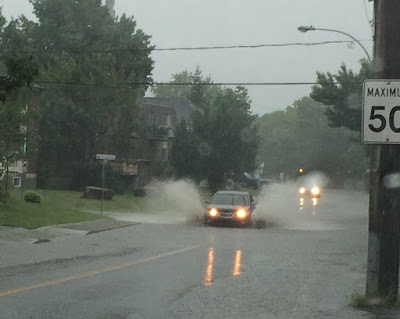 |
| Widespread damage occurred in the Saguenay region of Quebec on Wednesday, after baseball-size hail pounded the area. (TWN Photo courtesy Anne-Julie Belley) |
HOW DOES HAIL FORM?
Hail develops when strong updrafts in thunderstorms carry raindrops high into extremely cold regions of the atmosphere. Typically the storms in question are towering in nature, with cloud heights in excess of 30,000 feet. The raindrops freeze into balls of ice. The hailstone grows by colliding with super-cooled water droplets in the cloud. These freeze on contact with the evolving hailstone. The hail will be lifted multiple times into the upper portion of the thunderstorm, adding a layer of ice each time. Hail falls to the ground when the ice becomes too heavy for the updraft to maintain it, or the updraft weakens. Hail can be driven into the ground, cars, homes and people, by very strong winds that accompany the thunderstorm. The more severe the storm, the larger the hail. The hail can also merge with other stones, creating awkward and dangerous shapes. Hail has been know to cause widespread million-dollar damage. The largest hailstone reported in the US was in Vivian, South Dakota on June 23, 2010. It was 8 inches (20cm) in diameter, weighing in at 1 pound 15 ounces (878 grams). In Canada, the largest stone fell at Cedoux, Saskatchewan, on August 27, 1973. The hailstone was 11.4cm in diameter (4.5 inches), and weighed 290 grams (0.6 pounds).
 |
| Hail can damage windows and rip the siding from homes. (NOAA Photo) |














